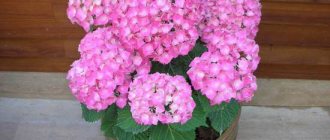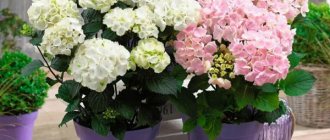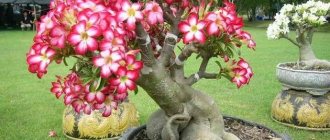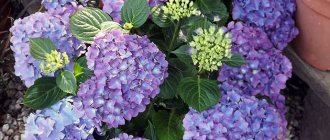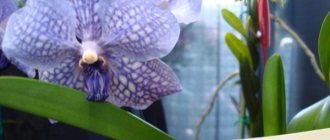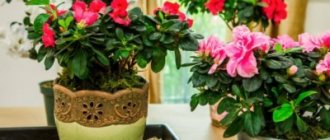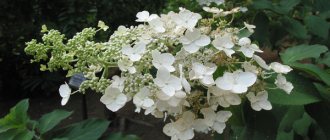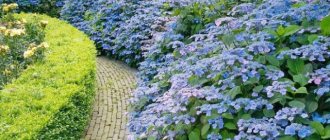The natural habitat of hydrangea is the American continent, as well as South and East Asia. Most species are found in China and Japan. In home floriculture, this plant is presented as a subshrub with spreading branches. The leaves are ovate-shaped and have serrated edges. The length of one sheet is within 10 - 15 cm.
The inflorescences are spherical, sometimes they are also called thyroid. The largest flowers are located at the edges. The minimum diameter of the inflorescence is 10 cm, and the maximum is 20 cm . Hydrangea has a fruit in the form of a box, which with its contours resembles a jug. In specialized literature, this flower can be found under the name hydrangea.
Indoor hydrangea is not as tall as garden hydrangea, although it can grow up to a meter in height. With proper care it blooms all summer .
Description
Hydrangea, or in the modern classification Hydrangea, is one of the most popular indoor and garden plants.
It received its name in honor of Princess Hortense. Later, scientists, while systematizing genera and species, gave it the name Hydrangea, taking as a basis the Greek words hydor and angeion - water and vessel. However, the former name remains more popular among amateur gardeners. Hydrangea belongs to the Hydrangeaceae or Hydrangiaceae family and is represented by 35 species. Their range, depending on the species, is quite wide: the countries of Southeast Asia and North America. Hydrangea is cultivated almost everywhere where conditions are suitable for its normal growth.
The genus is a shrubby or liana-like plant. The latter can reach a length of 30 m. Deciduous hydrangeas are more common, that is, they shed their foliage during the dormant period. As popular as the plant is, it is also recognizable thanks to its beautiful flowers of various shades, collected in large spherical or paniculate inflorescences.
Under natural conditions, the vast majority of Hydrangeas are white, but among cultivated species the shades are very diverse: pink, blue, purple, red. The color also depends on the acidity level of the soil. There are varieties with different shades in one inflorescence and corrugated edges of the petals.
The leaves of the plant are large, bright green, up to 10 cm in length. They have an oval shape with a pointed tip. The edge is decorated with small teeth. The greenery of the leaves effectively sets off the attractive inflorescences.
Such a variety of shapes and colors, a long flowering period, plus simple care allow Hydrangea to be widely used in interior design. In the warm season, it is recommended to keep it outdoors: on balconies, verandas, and in shaded areas of the garden.
Reproduction
A similar procedure can be carried out in several ways . Each option has its own advantages. Therefore, the choice of one method or another depends, by and large, on the wishes of the grower himself.
By cuttings
This method is considered the most correct. Planting material is prepared no later than January-February. Then by autumn you will have a lush bush . A cutting is cut from the root shoot, in which three internodes are formed.
The leaves from below are immediately removed, and the top is cut to half. The finished cutting is planted in a mixture of sand and peat , watered and covered with a glass cap. The container is ventilated daily and the soil is kept moist.
After 30 days, the cuttings will take root and can be transplanted into a small pot .
This video will tell you how to propagate hydrangea from cuttings.
Dividing the bush
It is convenient to combine division with transplantation . The larger the bush, the more divisions will come out. Each should have enough roots and shoots. They are shortened a little and planted in pots where the soil is specially prepared and moistened.
Seeds
They are sown closer to the end of winter. The most convenient container is boxes. Prepared soil for hydrangea is poured into them and a little humus is added. The seeds are laid out in the ground and not sprinkled with anything on top.
After watering, the containers are covered with film or glass. Every day the crops are ventilated and moistened. When the seedlings sprout, the covering is removed and the sprouts are thinned out. Sprouts with formed leaves dive into small glasses.
Advantages and disadvantages of hydrogen peroxide
The question often arises: is it worth using hydrogen peroxide in flower care?
The benefits of a mixture of water and peroxide have been proven repeatedly and this is confirmed by reviews from gardeners.
The first indisputable advantage of this substance is its accessibility. Hydrogen peroxide costs pennies compared to various chemical additives for plants. In addition, not all chemistry can benefit flowers. Some of them can cause irreparable harm.
The substance actively saturates the earth with oxygen, which results in a powerful and healthy root system. The effect of using a mixture of peroxide and water is manifested in the rapid growth of young flowers and seedlings. Flowering of plants begins earlier. A solution with peroxide disinfects the soil, preventing the development of rot and pathogenic bacteria. Prevents the appearance of pests or, when used in combination, fights them.
Nothing is known about the disadvantages of using a substance with peroxide. Only the amateur gardener himself can harm plants. This will result in an overdose of peroxide when used for watering or spraying. In this case, rot, wilting, lack of flowering, or death of the flower may occur with regular overdose.
Caring for indoor hydrangeas
It is necessary to care for a hydrangea in a pot, just like a free relative in the garden, by ensuring complete isolation from drafts, otherwise the foliage will begin to wither, until the plant dies, without the possibility of any resuscitation.
Watering mode
Any variety of hydrangea should be watered regularly, preventing the soil from drying out. The water must be left to stand at room temperature. During the flowering period, you need to monitor watering especially carefully.
In winter, soil moisture is also necessary, because the roots should not dry out even during the dormant period.
Top dressing
In summer, hydrangea is in dire need of mineral fertilizers. Additionally, during watering, you can add a small amount of potassium permanganate, which will protect the roots from infection. Without fertilizers, the plant may not enter the flowering stage and remain just a green shrub.
During the flowering period
Blooming hydrangea cannot be replanted so as not to disrupt the natural life cycle of the flower. The air temperature in the room where the blooming beauty lives should be maintained within the range from +18˚С to +22˚С. These are comfortable indications for all varieties.
During the rest period
When the hydrangea has retired, it needs to be moved to a place where the air does not warm up above +9 and does not cool below +5. If a flower is left on the windowsill all winter at room temperature, it will not feel the winter and will not bloom in the new season. For apartments, a balcony or an unheated staircase can become a place where the pot will sit all winter, benefiting future flowering.
Hydrangea doesn't bloom
Preparing for winter
Before wintering, all diseased or weak shoots are cut off, leaving no chance of infecting the entire plant, because treatment is a complex process and does not always result in a positive result. Pots with a plant of any variety and age are moved to a cool place where the shoots will not be blown by winds and subject to frost.
During the dormant period, hydrangea needs to trim dead inflorescences
Growing indoor varieties of hydrangea means bringing joy and bright colors to the windowsill. Indoor hydrangea does not require complex care at home and is ready to surprise with its shades. Following simple rules regarding temperature and frequency of watering will ensure abundant flowering almost all summer and all autumn.
Disease Control
Improper maintenance of Hydrangea Mix leads to the following problems:
- Aphids and spider mites. Spraying with soap solution, karbofos or actellik will help in destroying these pests.
- Gray rot. Occurs when overwatering. It is necessary to remove the infected parts of the plant and treat with Bordeaux mixture.
- Chlorosis (pale leaves). It is treated by adding magnesium, iron and manganese to the soil.
- Ring spot (brown spots on leaves). Treatment is carried out with a fungicide and the application of phosphorus-potassium fertilizers.
- Powdery mildew (brown leaves with a white coating). Treated in the same way as ring spot.
Hydrangea care at home photo: main nuances of content
Indoor hydrangea, which is properly cared for at home, will definitely thank you for your efforts with long and lush flowering.
Temperature and lighting
When deciding on a location for it, it is important to choose one where direct rays of the sun will not fall, but where there will be plenty of light. The ideal distance for hydrangea would be 2-3 meters from the window.
In this case, development will be normal, and light spots will not appear on the leaves.
As for temperature, the main thing is to avoid sudden fluctuations and protect the hydrangea from drafts. 19-22°C is exactly the indicator at which the flowers will feel as comfortable as possible. It is best to put hydrangea away for the winter in a dark, cool room (up to 9°C), for example, in a cellar, and return it back to the room closer to February. Without such a decrease in temperature, the plant will bloom only next year.
Indoor hydrangea care at home photo: watering and fertilizing
The second name of the flower, hydrangea (literally “a tub of water”), speaks of a great love for water. Hydrangea at home requires regular and generous watering in the summer, and more moderate watering in the off-season. In winter, you need to especially carefully control the amount of moisture in the flowerpots to avoid rotting of the root system and death of the plant.
Melt, rain or settled water is great for hydrangeas. Occasionally you can add lemon juice (5-7 drops per liter). This will help prevent the leaves from turning yellow. Systematic spraying and, of course, keeping the flower pots themselves away from heating appliances will help prevent them from drying out.
It is necessary to add organic and mineral fertilizers to the soil in the summer to speed up the development and flowering time of hydrangeas. Spraying with gibberellin (0.1 g per 1 liter of liquid) is also excellent for such purposes. With the appearance of the first flowers, a weak solution of manganese can be added to the irrigation water, and in winter, fertilizers can be abandoned altogether.
Indoor hydrangea care at home video
To better understand, watch the video in which Candidate of Biological Sciences, Elya Mamedova, confirms that this unpretentious plant can look flawless and truly excellent even for beginners.
https://youtube.com/watch?v=bMKtqDtGHpg
How to spray flowers with a solution, how to dilute it?
Spraying is an important point in caring for flowers. You need to spray flowers at least a couple of times a week. In winter, when indoor humidity is low due to heating and the use of heating devices, spraying must be done more often. Four times is considered the norm.
First, spray the plant stem. Then you need to move on to spraying the lower part with the leaves. Next comes the top part of the leaves. When spraying, you need to slightly lift them up a little.
Constantly spraying flowers brings undeniable benefits:
- new shoots grow faster;
- old, weak, fading leaves become stronger and grow;
- turgor becomes strong;
- the foliage of the flowers begins to grow thicker.
To prepare an aqueous substance to spray flowers, use the following dosage: 1 liter of settled tap water, 10 or 15 drops of peroxide. With frequent spraying, we make the solution weaker, with rare spraying, we make it stronger.
It is not recommended to apply spraying to plants with thin translucent and velvety-shaggy leaves. For example, you cannot spray caladium, violets, pelargonium and other similar flowers. Peroxide should only be applied to them during watering.
Important! If a white coating appears on the leaves, you should immediately stop using peroxide and, especially, chemical additives for plant nutrition.
Transfer
It is necessary to change the soil in which Hydrangea Mix grows once every two years. When transplanting, you must choose the right substrate. A mixture of peat, sand, turf and leaf soil in a ratio of 1:0.5:2:1 is best. For a horizontal hydrangea root system, a wide pot is best. There are two methods of transplantation:
- Transshipment method. For it, take a pot larger than the previous one and carefully replant the flower along with the old soil. The remaining voids are filled with fresh substrate.
- Complete transplant method. A thin layer of drainage is poured onto the bottom of the pot, the diameter of which is 1.5-2 centimeters larger than the previous one. Then some fresh substrate. Hydrangea Mix is cleaned of old soil and dried roots. Place the plant in a pot and sprinkle with the remaining soil.
In both cases, watering is not recommended. It is better to moisten the soil well before replanting.
